Related Research Articles
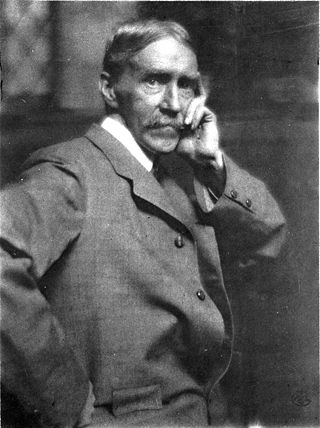
Maurice Brazil Prendergast was an American artist who painted in oil and watercolor, and created monotypes. His delicate landscapes and scenes of modern life, characterized by mosaic-like color, are generally associated with Post-Impressionism. Prendergast, however, was also a member of The Eight, a group of early twentieth-century American artists who, aside from Prendergast, represented the Ashcan School.
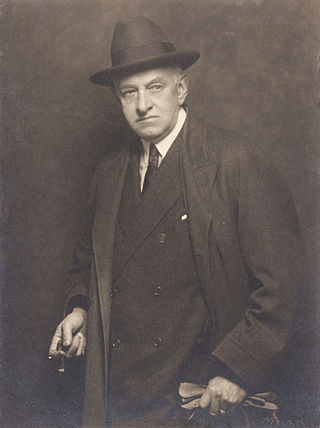
Willard Leroy Metcalf was an American painter born in Lowell, Massachusetts. He studied at the School of the Museum of Fine Arts, Boston, and later attended Académie Julian, Paris. After early figure-painting and illustration, he became prominent as a landscape painter. He was one of the Ten American Painters who in 1897 seceded from the Society of American Artists. For some years he was an instructor in the Women's Art School, Cooper Union, New York, and in the Art Students League, New York. In 1893 he became a member of the American Watercolor Society, New York. Generally associated with American Impressionism, he is also remembered for his New England landscapes and involvement with the Old Lyme Art Colony at Old Lyme, Connecticut and his influential years at the Cornish Art Colony.

Lilla Cabot Perry was an American artist who worked in the American Impressionist style, rendering portraits and landscapes in the free form manner of her mentor, Claude Monet. Perry was an early advocate of the French Impressionist style and contributed to its reception in the United States. Perry's early work was shaped by her exposure to the Boston School of artists and her travels in Europe and Japan. She was also greatly influenced by Ralph Waldo Emerson's philosophies and her friendship with Camille Pissarro. Although it was not until the age of thirty-six that Perry received formal training, her work with artists of the Impressionist, Realist, Symbolist, and German Social Realist movements greatly affected the style of her oeuvre.
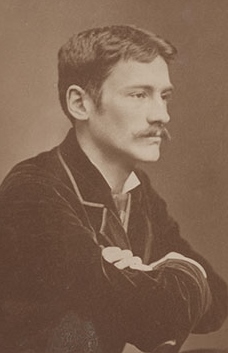
Thomas Wilmer Dewing was an American painter working at the turn of the 20th century. Schooled in Paris, Dewing was noted for his figure paintings of aristocratic women. He was a founding member of the Ten American Painters and taught at the Art Students League of New York. The Freer Gallery of Art at the Smithsonian Institution has a collection of his works. He was the husband of fellow artist Maria Oakey Dewing.

William Trost Richards was an American landscape artist. He was associated with both the Hudson River School and the American Pre-Raphaelite movement.

Frank Weston Benson, frequently referred to as Frank W. Benson, was an American artist from Salem, Massachusetts known for his Realistic portraits, American Impressionist paintings, watercolors and etchings. He began his career painting portraits of distinguished families and murals for the Library of Congress. Some of his best known paintings depict his daughters outdoors at Benson's summer home, Wooster Farm, on the island of North Haven, Maine. He also produced numerous oil, wash and watercolor paintings and etchings of wildfowl and landscapes.
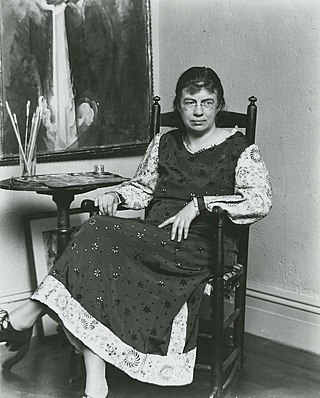
Marguerite Zorach was an American Fauvist painter, textile artist, and graphic designer, and was an early exponent of modernism in America. She won the 1920 Logan Medal of the Arts.

Dennis Miller Bunker was an American painter and innovator of American Impressionism. His mature works include both brightly colored landscape paintings and dark, finely drawn portraits and figures. One of the major American painters of the late 19th century, and a friend of many prominent artists of the era, Bunker died from meningitis at the age of 29.
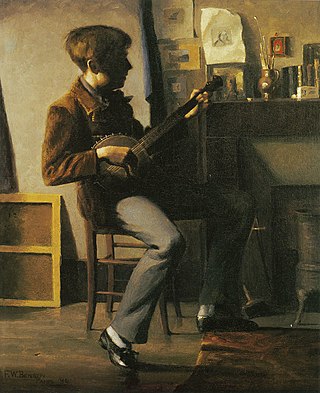
Joseph Lindon Smith ), was an American painter, best known for his extraordinarily faithful and lively representations of antiquities, especially Egyptian tomb reliefs. He was a founding member of the art colony at Dublin, New Hampshire.
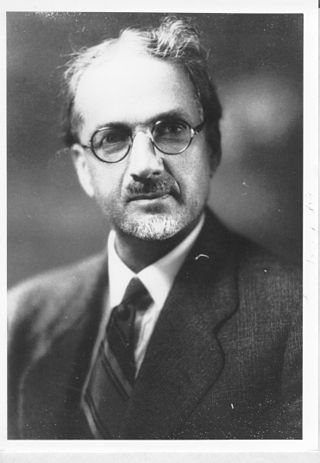
Albert Henry Krehbiel, was the most decorated American painter ever at the French Academy, winning the Prix De Rome, four gold medals and five cash prizes. He was born in Denmark, Iowa and taught, lived and worked for many years in Chicago. His masterpiece is the programme of eleven decorative wall and two ceiling paintings / murals for the Supreme and Appellate Court Rooms in Springfield, Illinois (1907–1911). Although educated as a realist in Paris, which is reflected in his neoclassical mural works, he is most famously known as an American Impressionist. Later in his career, Krehbiel experimented in a more modernist manner.

George Loftus Noyes (1864–1954) was a Canadian born artist who gained fame in the early 20th century as an American Impressionist.

The Boston School was a group of Boston-based painters active in the first three decades of the twentieth century. Often classified as American Impressionists, they had their own regional style, combining the painterliness of Impressionism with a more conservative approach to figure painting and a marked respect for the traditions of Western art history. Their preferred subject matter was genteel: portraits, picturesque landscapes, and young women posing in well-appointed interiors. Major influences included John Singer Sargent, Claude Monet, and Jan Vermeer. Key figures in the Boston School were Edmund C. Tarbell, Frank Weston Benson, and William McGregor Paxton, all of whom trained in Paris at the Académie Julian and later taught at the School of the Museum of Fine Arts. Their influence can still be seen in the work of some contemporary Boston-area artists.
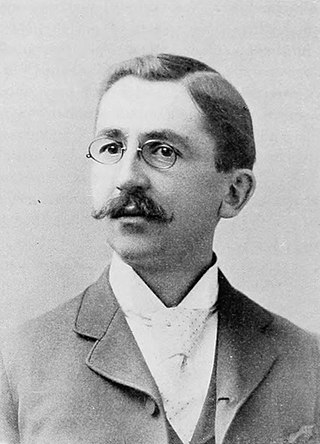
Abbott Fuller Graves (1859–1936) was an American painter and illustrator who specialized in decorative open air garden paintings and floral still lifes. His use of thick brushstrokes, bright colors, and natural light shows the influence of European impressionism.
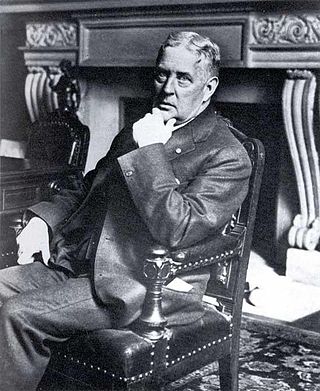
Edmund Charles Tarbell was an American Impressionist painter. A member of the Ten American Painters, his work hangs in the Boston Museum of Fine Arts, Metropolitan Museum of Art, National Gallery of Art, Smithsonian American Art Museum, Corcoran Gallery of Art, DeYoung Museum, National Academy Museum and School, New Britain Museum of American Art, Worcester Art Museum, and numerous other collections. He was a leading member of a group of painters which came to be known as the Boston School.

George Henry Hall (1825–1913) was an American still-life and landscape artist. He studied art in Düsseldorf and Paris and he worked and lived in New York City, the Catskills of New York and in Europe. His works are in museum collections in the United States and Europe. Over the course of his career he sold 1,659 paintings.

Sears Gallagher (1869–1955) was a prolific, commercially successful American artist proficient in multiple media: drawing, etching, watercolor and oil painting. His work consists largely of landscapes, seascapes, and cityscapes depicting his native Boston and northern New England, especially Monhegan Island, Maine. Illustrating magazines and books provided steady work and income, and his etchings and prints attracted popular demand. Gallagher took his art seriously, adapted new techniques, and was open to the influence of European Impressionism. During the height of his career his watercolors were favorably compared to those of Winslow Homer (1836–1910) and F. W. Benson (1862–1910), and his etchings and drypoints to those of James McNeill Whistler (1834–1903).
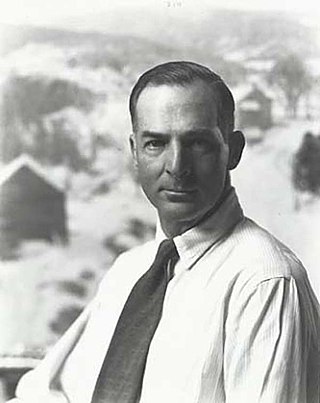
Harry "Tony" Leith-Ross was a British-American landscape painter and teacher. He taught at the art colonies in Woodstock, New York and Rockport, Maine, and later was part of the art colony in New Hope, Pennsylvania. A precise draftsman and a superb colorist, Leith-Ross is considered one of the Pennsylvania Impressionists.
William (Bill) Horace Littlefield was an American painter known for his figure studies of male nudes and in later life his large paintings in an abstract expressionist style.

Addison Thomas Millar was an American painter and artist; best known for his genre scenes and Orientalist paintings.

Hermann Dudley Murphy was an American painter, known mostly for still-lifes and landscapes. He also worked as an illustrator, art teacher and frame designer.
References
- ↑ "William J. Kaula". Smithsonian American Art Museum. Retrieved 2019-01-06.
- ↑ "William Jurian Kaula - The Cooley Gallery - American Impressionism, Hudson River School". www.cooleygallery.com. Retrieved 2019-01-06.
- ↑ "William Jurian Kaula | Art Auction Results". www.mutualart.com. Retrieved 2019-01-06.
- ↑ "William Jurian Kaula - Artworks". www.the-athenaeum.org. Retrieved 2019-01-06.
- ↑ Dunne, Susan (7 July 2018). "'Two Lives, One Passion' At Springfield Museums - Hartford Courant". courant.com. Retrieved 2019-01-06.
- ↑ Republican, Cori Urban Special to The (24 May 2018). "Springfield Museums examines 'Two Lives, One Passion'". masslive.com. Retrieved 2019-01-06.